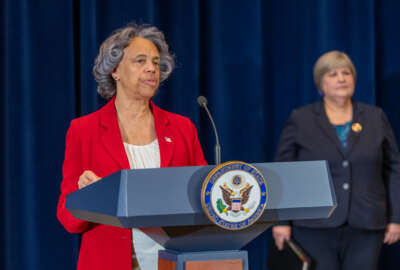Hubbard Radio Washington DC, LLC. All rights reserved. This website is not intended for users located within the European Economic Area.
3 promising pockets of success in Best Places to Work
In the 2023 Best Places to Work rankings, engagement is on the rise — and there are many pockets of success at agencies that don’t always see the spotlight.
The latest Best Places to Work results from the Partnership for Public Service are pretty promising — employee engagement is ticking upward for the first time in years, with many familiar agencies still topping the rankings.
But there are other pockets of success at agencies that don’t always see the spotlight. During a Best Places to Work event celebrating many of this year’s winners, some federal leaders were looking for what’s driving consistency at agencies, and how to make sure that keeps going.
It might not come as much of a surprise, for example, that the Government Accountability Office took the top spot this year for midsize agencies. GAO has remained the number one midsize agency in Best Places to Work now for four years in a row. For 2023, GAO’s engagement and satisfaction score was 87.2 out of 100.
The high score might come, at least in part, from the agency’s relatively new and more flexible telework program, said U.S. Comptroller General Gene Dodaro. During 2023, GAO worked alongside its union to expand workplace flexibilities for employees. The program now lets agency staff work fully remotely, with supervisor approval. Other employees can telework up to four days a week.
“That’s introducing a lot of administrative changes in the agency — it’s a big change,” Dodaro told Federal News Network at last week’s Best Places to Work event. “Since we were so successful at maintaining our quality of our work and productivity during the pandemic, I felt this was a good step.”
Data from the Partnership echoes that same telework-to-satisfaction trend at GAO. During 2023, across government, employees who teleworked full-time had the highest engagement, scoring about 75 out of 100 on how satisfied they feel in their jobs. By comparison, employees who work in headquarters offices and at field offices scored 69.2 and 61.7 on the same satisfaction scale, respectively.
There are plenty of other factors, though, that also influence employees’ engagement and satisfaction at work. For Dodaro, maintaining good communication between senior leaders and employees is another key component.
“We have monthly townhall meetings — I meet every year with each team and office and answer questions,” Dodaro said. “You need to maintain it because you constantly have new employees coming in. But once you have that institutional commitment and culture at the agency, things will pretty much take care of themselves.”
The importance of survey participation
For some agencies, improving engagement can be a little more complicated, and sometimes take years. In the Partnership’s 2023 Best Places to Work results, about two-thirds of agencies overall either maintained or increased their employee satisfaction scores. That means there’s another third of agencies whose scores decreased.
The National Transportation Safety Board, as an example, dropped down a couple spots in the 2023 rankings, going from 13th place to 18th place for small agencies. The board’s engagement and satisfaction score also dipped by 2.2 points, decreasing from 70.9 to 68.7 in one year. But for Veronica Marshall, chief human capital officer at NTSB, there’s still an upside this year.
“One of the things I’m most proud of is we had our highest participation rate in the last 12 years — almost 89% of the agency,” Marshall told Federal News Network at the Partnership event. “Our plan is really to just look at the results, focus on those key areas we think are most important to our workforce.”
Marshall said improving the participation rate for the Federal Employee Viewpoint Survey (FEVS) started at the top, with senior leadership. Since much of Best Places to Work comes from FEVS, Marshall turned her focus to educating leadership about the importance of the survey and making it clear to staff that senior leaders see a lot of value in employee feedback.
“They could, in turn, talk to the workforce about the importance of [FEVS] and how we really want to hear their opinions,” Marshall said.
That dynamic between senior leaders and employees gets a lot of credit for NTSB’s higher participation rates, but a little healthy competition didn’t hurt either. When the 2023 FEVS was out in the field, Marshall said she launched a competition among the board’s 13 different offices to see who could get the most employees to fill out the survey.
“At the end of that competition, the winner received a pizza party hosted and paid for by our chair,” Marshall said. “That healthy competition really helped to get our participation rates up.”
For Marshall, the next steps will be taking the feedback and data from employees and using it to try to improve the agency’s engagement and satisfaction score — and ideally, moving up in the Best Places to Work rankings.
“Again, really just listening to those opinions of the workforce and where we can pull those levers to help increase our scores,” Marshall said.
How workload can be a positive
Going down to an even smaller scale, agency subcomponents are also seeing some consistency in the rankings this year. The Office of Negotiations and Restructuring, an arm of the Pension Benefit Guaranty Corporation, once again placed first this year out of 459 agency subcomponents.
The office’s workload has increased in the last couple years, with more work stemming from a financial assistance program created as part of the American Rescue Plan Act. But for John Hanley, PBGC’s chief of negotiations and restructuring, that hasn’t been a detriment.
“My team has really risen to the occasion of meeting this demand to review these applications,” Hanley told Federal News Network at the Partnership’s event. “My team has just greatly enjoyed the challenge of keeping up with all of this, which I think has in turn led to an improvement in morale [and] energy. People are just dedicated to this role. [The work] is nonstop, but it’s been a real motivator.”
Like many other agency leaders, Hanley said employee feedback from FEVS, and high participation rates in the survey, are crucial.
“It is just a process of reminding people of the importance of being allowed to air their views via FEVS,” Hanley said. “There’s really just a component of making certain that people feel comfortable about that. I just avail people of the opportunity, make them aware of it, and then they follow through on their own volition.”
Getting higher participation often comes from whether employees actually think their input will be used to make changes. Employees are more likely to fill out a survey, like FEVS, if they see its results being taken seriously by leadership.
And governmentwide, that factor has been improving for the federal workforce. In the 2023 FEVS, on the question of whether employees believed the results of the survey would be used to make their agency a better place to work, results showed a 5-point increase.
The 2024 FEVS is currently out in the field for most agencies. At the Best Places to Work event, Office of Personnel Management Acting Director Rob Shriver urged agency leaders to work to keep those rates on an upward climb.
“This is really critical — really, really critical,” Shriver said. “I’m glad to see that the participation numbers have increased. So I would ask, once again, for a continued emphasis on making sure that we have strong participation in the survey. And as you all know, one of the things that’s really key to that is demonstrating to workers that their voice makes a difference.”
Copyright © 2024 Federal News Network. All rights reserved. This website is not intended for users located within the European Economic Area.
Drew Friedman
Drew Friedman is a workforce, pay and benefits reporter for Federal News Network.
Follow @dfriedmanWFED
Related Stories
Related Topics
All News
Best Places to Work
Best Places to Work in the Federal Government
Employee engagement
employee satisfaction
Federal Employee Viewpoint Survey
Federal Report
federal telework
Gene Dodaro
Government Accountability Office
John Hanley
Management
National Transportation Safety Board
Office of Personnel Management
Partnership for Public Service
Pension Benefit Guaranty Corporation
remote work
Rob Shriver
Veronica Marshall
Workforce





